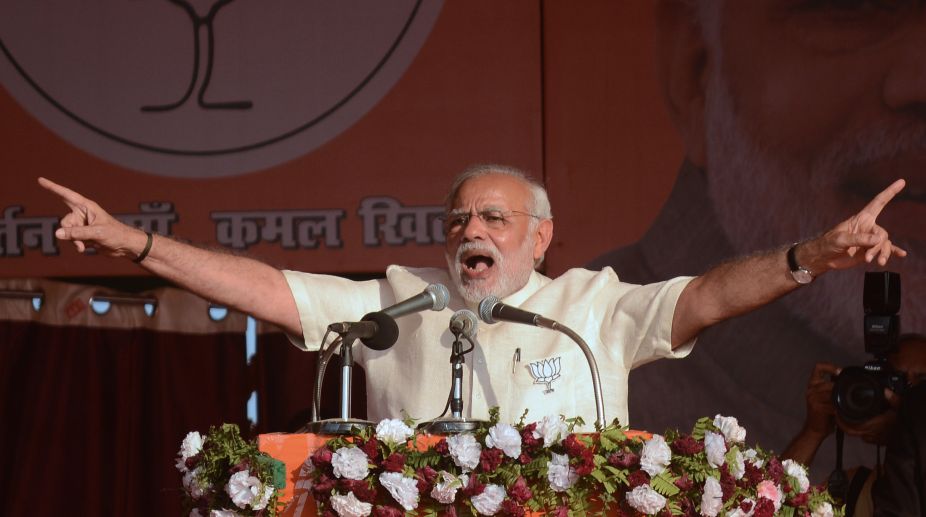As Prime Minister Narendra Modi completes three years in office on May 26 what is his report card on the political side? He enters his fourth year with a confidence that he will not only complete his term but also come back after the 2019 Lok Sabha polls. This is because of a weak opposition, which has not been able to get its act together.
Media reports quoting surveys claim that about 60 per cent of people believe that expectations from the Modi government have been met despite concerns on issues like law and order, inflation, terrorism and employment where the performance is not up to the mark. He has also scored high marks on foreign policy initiatives except on the India-Pakistan front. Modi has succeeded in giving a perception that he is a ‘doer' with his many welfare schemes like Make in India, Housing for all, Swachch Bharat and Jan Dhan Yojna. His political gimmicks of a surgical strike against Pakistan and the demonetisation of currency have helped him get votes. He has also been able to market India abroad with his high-pitch style. He touts his success by talking about the passage of the GST bill and power and banking sector reforms as big drivers of economy. The stock market also is booming and the growth story continues.
Advertisement
However, there are areas where Modi has not delivered, the biggest disappointment among them is providing jobs. Government data itself acknowledges that overall unemployment has risen by five per cent. The job growth is dismal as compared to the previous regime. The poll promises to create one crore jobs every year and depositing Rs 15 lakh in every bank account are yet to be met. The government needs to fix labour laws, skill up the youth and invest more in education and health sectors. For all the Centre’s tall promises the benefits of the welfare schemes are yet to percolate to the ground. Incidence of terrorism and youth unrest has not come down in Jammu and Kashmir. The Naxalites are raising their heads.
Overall, politically, Modi has done well for himself as well as his party. He continues to remain unchallenged and has strengthened the BJP further in the past three years. The BJP has formed governments on its own in four states for the first time – Maharashtra, Haryana, Assam and Manipur – and joined hands with the PDP to form its first coalition government in Jammu and Kashmir. It also came back to power in Jharkhand, Uttarakhand and Goa. It snatched UP from the Samajwadi Party. The party has also done well in grassroots civic body polls in Maharashtra, Odisha and Chandigarh besides marking a presence in West Bengal. However, the BJP expansion in southern states is still a dream for the party. It faced humiliation in Delhi and Bihar polls in 2015. On the other hand since 2014, the Congress has lost about a dozen states including Andhra Pradesh, Telengana, Jammu and Kashmir, Kerala, Maharashtra, and Uttarakhand. The saving grace was Punjab where it snatched power from the Akali Dal-BJP combine. It also became a coalition partner in Bihar. The Congress is facing a leadership crisis.
Various parties, led by leaders like Sonia Gandhi (Congress), Lalu Prasad Yadav (RJD), Nitish Kumar JD (U), Sitaram Yechuri (CPI- M), D. Raja (CPI) and Sharad Pawar (NCP), to name a few, have been making efforts for opposition unity, which is eluding them so far. The acid test now may be in the upcoming presidential and vice presidential polls in August. It will be significant if the opposition can put up a good fight although it will only be a token contest as the BJP has the adequate numbers to get its vice presidential nominee and it is just short of 25,000 votes for the presidential nominee. This shortfall can be bridged by parties like the BJD, AIADMK, TRS, YSR Congress and other smaller parties.
Secondly, the opposition needs to change its strategy of criticising Modi on every step he had taken, as it has not made any impact with the public so far. The opposition plank of a secular-communal divide also has not clicked and on the contrary, the BJP seems to be surging forward by becoming a pan-national party overtaking the Congress. It has to come up with an alternative narrative, which will appeal to the voters or else the BJP’s expansion will continue.
Thirdly, Modi has complete control of the party and the government as senior leaders like L.K. Advani and Dr Murli Mahohar Joshi have been sidelined for the past three years. He has been able to implement his orders through party chief Amit Shah. He has established his supremacy in the party by nominating candidates of his choice as chief ministers of Maharashtra, Haryana, Goa and other BJP ruled states. UP chief minister Yogi Adityanath is an RSS nominee.
Modi enters his fourth year with confidence despite not fulfilling some important promises. There are still two more years for the opposition to strategise but if it does not unite, the TINA (There Is No Alternative) factor will help Modi.









